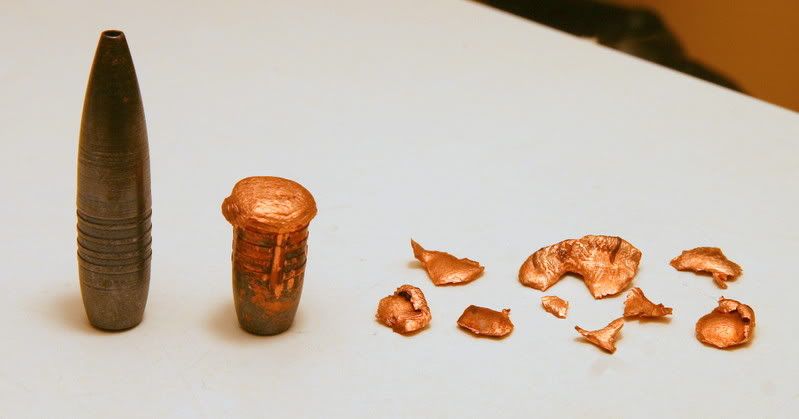

 The Accurate Reloading Forums
The Accurate Reloading Forums  THE ACCURATE RELOADING.COM FORUMS
THE ACCURATE RELOADING.COM FORUMS  Guns, Politics, Gunsmithing & Reloading
Guns, Politics, Gunsmithing & Reloading  Reloading
Reloading  GS Custom 150 gr. GS HV @ 3200 fps fired into pool (Picture)
GS Custom 150 gr. GS HV @ 3200 fps fired into pool (Picture)Go  | New  | Find  | Notify  | Tools  | Reply  |  |
| one of us |
Bullet: GS Custom 150 gr. GS HV Caliber: 300 WSM Velocity: 3200 fps I fired this round into the deep end of the swimming pool at the same distance and angle as the previous tests. (.308 cal - 150 gr. Combined Tech BT ) ( .224 – 40 gr. GS HV ) RESULTS Core weight: 91.5 grains (61% of original 150 gr. weight) Recovered pieces: 34 grains What do you think of the results? Did you expect the core weight to be greater, less, or about the same as is the 61% found here? Your opinion is appreciated.  | ||
|
| one of us |
That is interesting. I would have thought the frontal area would have been larger. Gerard can probably tell us why the fragmentation occured, for all I know that is the design intent, kind of like a Partition, the frontal area sheds, and the base/core remains intact for penetration and often passes through. Although at first glance, I don't like all of the fragmentation, it may be perfect for killing of critters, I am not sure which is better, have read a lot on bullets, and the jist is that this type of result can be good, but intact, larger frontal areas cause a greater 'wound channel' and tend to be preferred. Again, no one can ever seem to find anything bad to say about a partition, except perhaps inaccuracy on ocassion, and it performs similarly I believe. Do the shed pieces account for the balance of weight between the starting weight and the remaining 'core' weight? | |||
|
| one of us |
Hey Fish- Thanks for you comments. To answer your question about the fragments, being that this is November and the pool is getting chilly As you can see the remaining cylindrical shank is much shorter than the original bullet length. After measuring the hollow point cavity, it appears as if the expansion and shedding of material stopped just after the bottom of the hollow point. It seems like varying the depth of the hollow point might be a good way to adjust weight retention of this type of bullet. You an see the hollow point cavity here:  Regarding the wound channel, my understanding is that a flat metplat, like that found on the solid dangerous game bullets, displaces tissue even greater than a round or pointed bullet. Supposedly the GS HV bullet is designed to quickly shed pedals at velocities above 2,600 fps and then allow the cylindrical shaped shank to continue through with the remaining momentum and flat frontal metplat. The nose section is suppose to expand within 10-20 bullet lengths upon impact. Regarding the "quick expansion", I did notice that a great majority of the debris from the nose section of the bullet settled relatively close to the surface impact position. The actual bullet core settling much further away. It seems to roughly support the theory of quick expansion. | |||
|
| Powered by Social Strata |
| Please Wait. Your request is being processed... |
|
 The Accurate Reloading Forums
The Accurate Reloading Forums  THE ACCURATE RELOADING.COM FORUMS
THE ACCURATE RELOADING.COM FORUMS  Guns, Politics, Gunsmithing & Reloading
Guns, Politics, Gunsmithing & Reloading  Reloading
Reloading  GS Custom 150 gr. GS HV @ 3200 fps fired into pool (Picture)
GS Custom 150 gr. GS HV @ 3200 fps fired into pool (Picture)

Visit our on-line store for AR Memorabilia

